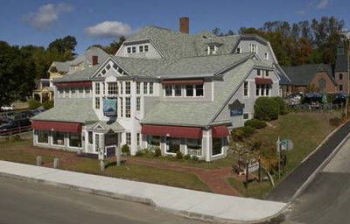WILLIMANTIC BREWING
 WILLIMANTIC, CONNECTICUT
Out of the rural hilly sticks in central Connecticut pops up the small metropolis of Willimantic, home of arguably the best Northeast brewpub, originally visited October ’07. Over a frog-pillared bridge in a historic street-cornered granite-limestone ex-post office, WILLIMANTIC BREWING (formerly Main Street Café) has cozy left side wood bar with eclectic wall-bound specialty tap handles, windowed side tables, and encased brew tanks plus separate right dining area.
Bottled beer selection included amiable local, English, Irish, and Belgian ales. And though I sleepwalked through acrid wheat-oats-fronted, dry-hopped, grapefruit rind-embittered Certified Gold, subtly citric-hopped corn-sugared Mail Carrier Maybock and cardboard-y fruit-crimped pecan-skimped oxidation Autobahn Alt on my initial stopOver, the proceeding seasonal offerings were terrific.
Scotch-rye-affixed, fig-date-tinged, raw-honeyed Extra Postage Pub Ale went down gently alongside flatbread pizza, nachos, and sandwiches.
Most Wanted IPA had illustrious grapefruit-peach-mango burst harboring Cascade-hopped maple-sapped piney bark bittering.
Well-calibrated Willi Whammer Barleywine boasted 10% alcohol-soaked cherry luster, bruised orange-banana sweetness, teasing brandy snipe, and buttery vanilla finish.
During March ’09 revisit, discovered five more worthy brews. Vienna-malted Saaz-hopped corn-sugared hop-spiced Czech In The Mail suited connoisseurs and nubians alike.
Cask-conditioned barrel-aged cider-sharp grape-soured fig-dried Willi Funk Hammer maintained tart tannic acidity.
Piney citric-spiced pear-sweet grapefruit-embittered Pushing The Envelope Extreme Unfiltered Double IPA possessed heady ethanol flare.
Citrus-tingled honey-sweetened pilsner-malted Springfest and unfiltered tea-like cocoa-powdered fig-sugared honeycomb-finishing Winter’s Dunkel had easy appeal.
Amazingly, on my third trip to Willimantic Brewing, February 2011, there were seven (!) more new beers to try. I’d already quaffed eleven preferable libations on my past two visitations, but there were two amazingly distinct and differentiated stouts to discover as well as a terrific IPA, expressive pale ale, and four other favorites.
My wife and I settled into a vegetal pizza while dipping into lightest fare, dry-hopped German Pils, Hope & Hops, a perfumed corn-husked wheat-grassed moderation with lemony grapefruit tingle that may’ve topped tranquil Carrier’s Credo Cream. The latter, a dry-bodied grassy-hopped maize-flaked wheat-cracked clover-honeyed cream ale, placed cooked veggie, orange rot, lemon meringue, and white apricot illusions in the subtle backdrop.
Bettering those promising openers were three diversified medium body brews. Excellent Spam Mail Pale Ale brought woody Amarillo hop parch to dry lemon-seeded grapefruit-juiced grape tannin, apple skin, apricot, orange, and tangerine tartness contrasting ascending honey-sugared crystal malting.
Creamy Double Black IPA retained intense hop-roasted tobacco chew, black cherry, prune, raisin and fig frenzy contrasting rich chocolate malt durability.
Nearly as fine, Scarlet Letter Red situated sweet caramel-crystal malting alongside dry spice-hopped alacrity and compost-wafted vegetal mineral graining.
An engaging sidestep, Scotch Tapped Scottish Ale diverted away from any restrictive regimented style with its Band-aided beechwood-smoked peat malting contrasting sweet honey nuttiness.
I was admiring the terrific, colorful tap handle collection above the walnut bar while imbibing astonishingly reciprocal dessert treats. As much as I enjoyed creamy espresso-coffee fronted Just Stout, with its dry hop-roasted vanilla bean bittering coarsening black chocolate, anise, hazelnut, and walnut illusions, its chocolate-milked counterpart reached nirvana quicker.
A perfect chocolate dessert beer, S.W.A.K. Stout, advanced creamy brown chocolate sugaring and rich vanilla sweetness above soothing coffee roast, allowing rich chocolate cake, Belgian chocolate, and Hershey Kiss opulence to spread across the mouth.
My long-time pal, Dennis Flubacher, brought back growlers of two previously untried brews, May 2011. Roaden Zok Flanders Sour Red Ale retained crisply tart green apple spicing and hard cider pucker above fig-dried oaken cherry, vinous white grape, and sour pomegranate fruiting, embittering raspberry-boysenberry conflux along the way.
Next up, Victorian Neighbor Pale Ale placed caraway-seeded rye breading and caramel-roasted chocolate nibs snip atop fungi yellow-fruited apicot-fig dryness for proper English ale styling.
Quaffed another five rangy brews during 2011 winter solstice (December 21st) on trip back from Boston with wife and daughter. One of the most popular local selections, Rail Mail Rye, maintained a soft, unfiltered flow with fig-dried citric rye gently caressing mild hop peppering.
A sturdier dried fruiting spread across brown sugared, dark-spiced Edge Of Darkness Brown Ale.
Just as approachable and twice as delectable, Pushing The Envelope Double IPA plied brown-sugared cinnamon spicing inside orange-cherry fruiting, crystal malted sugaring, wood-singed walnut sharpness and sweet hazelnut clusters.
Nearly as great, Coco Porter took dry cocoa powder and smoked chocolate malts to the soft black cherry midst, where mild caramel latte, milked coffee and espresso illusions claimed ground.
As for the wintry seasonals, unobtrusive Winter Fest had a musty dry-hopped fig-plum-date astringency and very little spicing.
But 1st Class Festive Imperial IPA doused a load of brown-sugared cinnamon spicing inside sugary crystal malting, leaving wood-singed dried cherry, hazelnut and walnut undertones.
www.willibrew.com
WILLIMANTIC, CONNECTICUT
Out of the rural hilly sticks in central Connecticut pops up the small metropolis of Willimantic, home of arguably the best Northeast brewpub, originally visited October ’07. Over a frog-pillared bridge in a historic street-cornered granite-limestone ex-post office, WILLIMANTIC BREWING (formerly Main Street Café) has cozy left side wood bar with eclectic wall-bound specialty tap handles, windowed side tables, and encased brew tanks plus separate right dining area.
Bottled beer selection included amiable local, English, Irish, and Belgian ales. And though I sleepwalked through acrid wheat-oats-fronted, dry-hopped, grapefruit rind-embittered Certified Gold, subtly citric-hopped corn-sugared Mail Carrier Maybock and cardboard-y fruit-crimped pecan-skimped oxidation Autobahn Alt on my initial stopOver, the proceeding seasonal offerings were terrific.
Scotch-rye-affixed, fig-date-tinged, raw-honeyed Extra Postage Pub Ale went down gently alongside flatbread pizza, nachos, and sandwiches.
Most Wanted IPA had illustrious grapefruit-peach-mango burst harboring Cascade-hopped maple-sapped piney bark bittering.
Well-calibrated Willi Whammer Barleywine boasted 10% alcohol-soaked cherry luster, bruised orange-banana sweetness, teasing brandy snipe, and buttery vanilla finish.
During March ’09 revisit, discovered five more worthy brews. Vienna-malted Saaz-hopped corn-sugared hop-spiced Czech In The Mail suited connoisseurs and nubians alike.
Cask-conditioned barrel-aged cider-sharp grape-soured fig-dried Willi Funk Hammer maintained tart tannic acidity.
Piney citric-spiced pear-sweet grapefruit-embittered Pushing The Envelope Extreme Unfiltered Double IPA possessed heady ethanol flare.
Citrus-tingled honey-sweetened pilsner-malted Springfest and unfiltered tea-like cocoa-powdered fig-sugared honeycomb-finishing Winter’s Dunkel had easy appeal.
Amazingly, on my third trip to Willimantic Brewing, February 2011, there were seven (!) more new beers to try. I’d already quaffed eleven preferable libations on my past two visitations, but there were two amazingly distinct and differentiated stouts to discover as well as a terrific IPA, expressive pale ale, and four other favorites.
My wife and I settled into a vegetal pizza while dipping into lightest fare, dry-hopped German Pils, Hope & Hops, a perfumed corn-husked wheat-grassed moderation with lemony grapefruit tingle that may’ve topped tranquil Carrier’s Credo Cream. The latter, a dry-bodied grassy-hopped maize-flaked wheat-cracked clover-honeyed cream ale, placed cooked veggie, orange rot, lemon meringue, and white apricot illusions in the subtle backdrop.
Bettering those promising openers were three diversified medium body brews. Excellent Spam Mail Pale Ale brought woody Amarillo hop parch to dry lemon-seeded grapefruit-juiced grape tannin, apple skin, apricot, orange, and tangerine tartness contrasting ascending honey-sugared crystal malting.
Creamy Double Black IPA retained intense hop-roasted tobacco chew, black cherry, prune, raisin and fig frenzy contrasting rich chocolate malt durability.
Nearly as fine, Scarlet Letter Red situated sweet caramel-crystal malting alongside dry spice-hopped alacrity and compost-wafted vegetal mineral graining.
An engaging sidestep, Scotch Tapped Scottish Ale diverted away from any restrictive regimented style with its Band-aided beechwood-smoked peat malting contrasting sweet honey nuttiness.
I was admiring the terrific, colorful tap handle collection above the walnut bar while imbibing astonishingly reciprocal dessert treats. As much as I enjoyed creamy espresso-coffee fronted Just Stout, with its dry hop-roasted vanilla bean bittering coarsening black chocolate, anise, hazelnut, and walnut illusions, its chocolate-milked counterpart reached nirvana quicker.
A perfect chocolate dessert beer, S.W.A.K. Stout, advanced creamy brown chocolate sugaring and rich vanilla sweetness above soothing coffee roast, allowing rich chocolate cake, Belgian chocolate, and Hershey Kiss opulence to spread across the mouth.
My long-time pal, Dennis Flubacher, brought back growlers of two previously untried brews, May 2011. Roaden Zok Flanders Sour Red Ale retained crisply tart green apple spicing and hard cider pucker above fig-dried oaken cherry, vinous white grape, and sour pomegranate fruiting, embittering raspberry-boysenberry conflux along the way.
Next up, Victorian Neighbor Pale Ale placed caraway-seeded rye breading and caramel-roasted chocolate nibs snip atop fungi yellow-fruited apicot-fig dryness for proper English ale styling.
Quaffed another five rangy brews during 2011 winter solstice (December 21st) on trip back from Boston with wife and daughter. One of the most popular local selections, Rail Mail Rye, maintained a soft, unfiltered flow with fig-dried citric rye gently caressing mild hop peppering.
A sturdier dried fruiting spread across brown sugared, dark-spiced Edge Of Darkness Brown Ale.
Just as approachable and twice as delectable, Pushing The Envelope Double IPA plied brown-sugared cinnamon spicing inside orange-cherry fruiting, crystal malted sugaring, wood-singed walnut sharpness and sweet hazelnut clusters.
Nearly as great, Coco Porter took dry cocoa powder and smoked chocolate malts to the soft black cherry midst, where mild caramel latte, milked coffee and espresso illusions claimed ground.
As for the wintry seasonals, unobtrusive Winter Fest had a musty dry-hopped fig-plum-date astringency and very little spicing.
But 1st Class Festive Imperial IPA doused a load of brown-sugared cinnamon spicing inside sugary crystal malting, leaving wood-singed dried cherry, hazelnut and walnut undertones.
www.willibrew.com MOAT MOUNTAIN SMOKE HOUSE & BREWING
WOODSTOCK INN STATION
 WHITE MOUNTAINS, NEW HAMPSHIRE
20 miles South of Italian Oasis in the heart of the White Mountains lies placid cedar-faced North Woodstock brewpub, WOODSTOCK INN STATION (visited December ’06).
Located behind a nostalgic Victorian country inn, its side-windowed brew tanks (wood-jacketed; stainless steel; brick-based), multiple cozy dining areas, and central low-ceilinged wood paneled bar provide rural splendor. Large menu included well-portioned pizza, steak, seafood, and chicken items while bar fare included frozen margaritas and daiquiris plus transcontinental coffee and mostly excellent brews crafted by Butch Chase and Rick Marley.
Seven-barrel fermentation system below ground level offered biscuit-honeyed maple-syrupy White Mountain Weasel and eloquently brandied cherry-fig-tangerine-bruised prune-stewed bread-buttered sedation Wassail Ale on the moderate side.
Healthier thirsts will gravitate towards tangy heavy-hopped citric-laced Pemi Pale Ale, silkily maple-birch-sweetened Kano Country Maple Porter, brown chocolate-coarsened nutty-ruddy hop-toasted cologne-musked black tea-like Pig’s Ear Brown Ale, and tenderly barley-roasted coffee-dried Old Man Oatmeal Stout.
www.woodstockinnnh.com
WHITE MOUNTAINS, NEW HAMPSHIRE
20 miles South of Italian Oasis in the heart of the White Mountains lies placid cedar-faced North Woodstock brewpub, WOODSTOCK INN STATION (visited December ’06).
Located behind a nostalgic Victorian country inn, its side-windowed brew tanks (wood-jacketed; stainless steel; brick-based), multiple cozy dining areas, and central low-ceilinged wood paneled bar provide rural splendor. Large menu included well-portioned pizza, steak, seafood, and chicken items while bar fare included frozen margaritas and daiquiris plus transcontinental coffee and mostly excellent brews crafted by Butch Chase and Rick Marley.
Seven-barrel fermentation system below ground level offered biscuit-honeyed maple-syrupy White Mountain Weasel and eloquently brandied cherry-fig-tangerine-bruised prune-stewed bread-buttered sedation Wassail Ale on the moderate side.
Healthier thirsts will gravitate towards tangy heavy-hopped citric-laced Pemi Pale Ale, silkily maple-birch-sweetened Kano Country Maple Porter, brown chocolate-coarsened nutty-ruddy hop-toasted cologne-musked black tea-like Pig’s Ear Brown Ale, and tenderly barley-roasted coffee-dried Old Man Oatmeal Stout.
www.woodstockinnnh.com ITALIAN OASIS RESTAURANT & BREWERY
 LITTLETON, NEW HAMPSHIRE
Plainly put, there were three interesting brewpubs running the gamut encircling snowy White Mountain region on December ’06 trip. Located on the second floor above Elephant’s Trunk in bustling mid-state village of Littleton, ITALIAN OASIS RESTAURANT & BREWERY featured inexpensive pub fare, small carpeted seating area, and sled-lined oak bar, but went out of business around 2014.
Brew tanks nestled alongside kitchen served unfiltered raw-honeyed wheat-chaffed diacetyl-tinged Oasis Golden Ale, prickly-hopped dry-grained orange-grapefruit-soured Cannon Amber Ale and soft-tongued barley-stacked licorice-doused walnut-dried ice coffee-finishing Black Bear Stout.
Parkers Marketplace, 106 Main Street, Littleton, NH
LITTLETON, NEW HAMPSHIRE
Plainly put, there were three interesting brewpubs running the gamut encircling snowy White Mountain region on December ’06 trip. Located on the second floor above Elephant’s Trunk in bustling mid-state village of Littleton, ITALIAN OASIS RESTAURANT & BREWERY featured inexpensive pub fare, small carpeted seating area, and sled-lined oak bar, but went out of business around 2014.
Brew tanks nestled alongside kitchen served unfiltered raw-honeyed wheat-chaffed diacetyl-tinged Oasis Golden Ale, prickly-hopped dry-grained orange-grapefruit-soured Cannon Amber Ale and soft-tongued barley-stacked licorice-doused walnut-dried ice coffee-finishing Black Bear Stout.
Parkers Marketplace, 106 Main Street, Littleton, NH RIVER CITY ALE WORKS
SEVEN BARREL BREWERY
 WEST LEBANON, NEW HAMPSHIRE
Across the Connecticut River one mile from Vermont’s White River Junction lies West Lebanon marvel, SEVEN BARREL BREWERY (1993-2016), a free standing wood-bedecked restaurant-styled brewpub in Colonial Plaza that gave first-rate Vermont competitor Mc Neill’s a run for the money, February ’04.
Soft watered lemon-spiced Quechee Cream Ale, doughy wheat-backed apple-grapefruit-soured Ice Rock Canadian Golden Ale, orange rind-embittered floral-spiced Red 7 Ale, frisky orange-lemon peel-embittered Champion Reserve IPA,and raw-honeyed citric-hopped mocha-malted Original Barrel Vienna Lager went well with appetizers.
Nutty coffee-roasted New Dublin Brown Ale, coffee bean-seduced Mick Jack Porter and spice-hopped black cherry-fronted licorice-accented R.I.P. Imperial Stout retained mocha certainty.
For perky fruited pick-me-up, brewer Paul White pours syrupy peach juice into kitsch-y Quechee Ale, creating ginger-y citric-berry-ripened sugar-lacquered lemon-dropped Peach Quechee Ale.
Seated next to windowed left side brew tanks with family December ‘05, quaffed medicinal, black cherry soda-like, birch beer-hinted, nutty-countered Cherry Brown Ale, soft-fizzed candi-sugared blueberry-ripened Blueberry Quechee Cream Ale, delicately pine-hopped cherry-soured grapefruit-embittered acerbity Cask Conditioned Champion Reserve IPA and creamy chocolate-roasted coffee-emblazoned cherry-bruised raspberry-pureed tobacco-chewed Raspberry Stout.
Revisited November ’06, sampling tea-honeyed, dried prune-soured, date-fig-recessed, wort-scented Scotch Ale.
January ’08, stopped in for likable cereal-grained fruit-spiced crystal-malted Paul’s Pale Ale.
New Year’s Day, 2010, sojourned back for soapy soft-hopped pumpkin-pied cinnamon-coriander-spiced Jenna-Lantern Ale and tea-like cocoa-soured earthen-backed grassy-hopped ESB.
Within walking distance of Seven Barrel, The Beverage King sold several local brews.
www.7barrel.com
phone: 603 298 5566
WEST LEBANON, NEW HAMPSHIRE
Across the Connecticut River one mile from Vermont’s White River Junction lies West Lebanon marvel, SEVEN BARREL BREWERY (1993-2016), a free standing wood-bedecked restaurant-styled brewpub in Colonial Plaza that gave first-rate Vermont competitor Mc Neill’s a run for the money, February ’04.
Soft watered lemon-spiced Quechee Cream Ale, doughy wheat-backed apple-grapefruit-soured Ice Rock Canadian Golden Ale, orange rind-embittered floral-spiced Red 7 Ale, frisky orange-lemon peel-embittered Champion Reserve IPA,and raw-honeyed citric-hopped mocha-malted Original Barrel Vienna Lager went well with appetizers.
Nutty coffee-roasted New Dublin Brown Ale, coffee bean-seduced Mick Jack Porter and spice-hopped black cherry-fronted licorice-accented R.I.P. Imperial Stout retained mocha certainty.
For perky fruited pick-me-up, brewer Paul White pours syrupy peach juice into kitsch-y Quechee Ale, creating ginger-y citric-berry-ripened sugar-lacquered lemon-dropped Peach Quechee Ale.
Seated next to windowed left side brew tanks with family December ‘05, quaffed medicinal, black cherry soda-like, birch beer-hinted, nutty-countered Cherry Brown Ale, soft-fizzed candi-sugared blueberry-ripened Blueberry Quechee Cream Ale, delicately pine-hopped cherry-soured grapefruit-embittered acerbity Cask Conditioned Champion Reserve IPA and creamy chocolate-roasted coffee-emblazoned cherry-bruised raspberry-pureed tobacco-chewed Raspberry Stout.
Revisited November ’06, sampling tea-honeyed, dried prune-soured, date-fig-recessed, wort-scented Scotch Ale.
January ’08, stopped in for likable cereal-grained fruit-spiced crystal-malted Paul’s Pale Ale.
New Year’s Day, 2010, sojourned back for soapy soft-hopped pumpkin-pied cinnamon-coriander-spiced Jenna-Lantern Ale and tea-like cocoa-soured earthen-backed grassy-hopped ESB.
Within walking distance of Seven Barrel, The Beverage King sold several local brews.
www.7barrel.com
phone: 603 298 5566 JOHNSTOWN BREWING

Carved out atop a busy Industrial valley and tied to its local steel town heritage and Old Colonial village, huge chateau-styled JOHNSTOWN BREWING was established September, 2003, visited April ’06, but closed 2008. Located in the heart of Pennsylvania, its upper level offers fireplace waiting area, left side bar, large eating area, and ample back deck with great window view of the river-based canyon.
Lower level seats 120 patrons and contains brew kettles, secondary bar and deck, mug club station, and hanging growlers boasting Johnstown and competitors insignias.
Lighter drinkers will lean towards popcorn-buttered wheat-maize-backed Flood Light, summery yellow-fruited mildly-hopped South Fork Dam Kolsch and dry red-fruited peppery-hopped cocoa-malted 1889 Amber Ale.
But friendly brewer Barrett Goddard’s finer elixirs included easy flowing subtly roasted caramel-chocolate-y hazelnut-macadamia-dashed Scottish-styled Stone Bridge Brown Ale, sharply bitter red-orange-fruited off-dry White Hat Pale Ale, buttery Scotch-licked red apple-sweet seasonal Lovette Brothers Irish Red Ale and arid clover honeyed peach-apricot-soured cereal-backed perfume-wafted Honey Raspberry Wheat.
Perhaps the best Dortmunder knockoff I’ve imbibed, the malt-sticky Incline Plaine plopped caramelized apple, pear, and apricot alongside dry-fruited grapefruit-fig bitterness.
For a closer, quaffed dry Irish-styled Steel Workers Stout, a mild workingman’s brew merging roasted coffee, black chocolate, and bitter nuttiness.
FOXBURG INN ON THE ALLEGHENY
BLUE CANOE BREWERY (FOUR SONS)
NORTH COUNTRY BREWERY
RED STAR BREWERY
 WESTERN PENNSYLVANIA
In the bustling small metropolis of Greensburg, 40 miles East of Pittsburgh in Laurel Highlands section, RED STAR BREWERY had offered excellent Americana fare (lobster, crab cakes, fire grilled lamb lollipops, and butcher’s cut steak on the high end) plus quality brews since October ’98. But by 2010, it closed down.
Formerly located at the train station in a stately red brick Victorian building with clock tower and Cathedral spires, its small front porch conveniently led into brew tank-addled hallway then central bar with glass-enclosed copper kettles and ample TV’s. Wooden furnishings adorn surrounding dining area and an upstairs loft bedecks the left side.
April ’06, brewer Jeff Guidos and I sampled his lauded suds at high noon, beginning with phenol raw-grained lime-soured pepper-hopped oats-maized Redstar Golden Light (strictly for proletariat), bitter hop-grained fig-dried Locomotive Breath Steam Beer and mild hop-embittered red-fruited sedation Canvasback American Pale Ale (a nitro-injected smoothie with creamy Guinness head).
More intriguing were heartland-grained peat-framed honey-spiced rye-tinged 4 Grain Ale, oats-honeyed, orange-apricot soured, kiwi-mango-pineapple-tinged Mai-Effin Maibock, and fermented tea-like, barley-hopped, dry-bodied Extra Special Bitter.
Best bets for headier thirsts were darker brews such as caffeinated coffee-burnt, cocoa bean-soured Coffee Porter and silken nitro-injected Milk Stout (with its roasted coffee-mocha surge, coarse nuttiness, and creamy milk chocolate froth).
www.redstarbrewery.com
WESTERN PENNSYLVANIA
In the bustling small metropolis of Greensburg, 40 miles East of Pittsburgh in Laurel Highlands section, RED STAR BREWERY had offered excellent Americana fare (lobster, crab cakes, fire grilled lamb lollipops, and butcher’s cut steak on the high end) plus quality brews since October ’98. But by 2010, it closed down.
Formerly located at the train station in a stately red brick Victorian building with clock tower and Cathedral spires, its small front porch conveniently led into brew tank-addled hallway then central bar with glass-enclosed copper kettles and ample TV’s. Wooden furnishings adorn surrounding dining area and an upstairs loft bedecks the left side.
April ’06, brewer Jeff Guidos and I sampled his lauded suds at high noon, beginning with phenol raw-grained lime-soured pepper-hopped oats-maized Redstar Golden Light (strictly for proletariat), bitter hop-grained fig-dried Locomotive Breath Steam Beer and mild hop-embittered red-fruited sedation Canvasback American Pale Ale (a nitro-injected smoothie with creamy Guinness head).
More intriguing were heartland-grained peat-framed honey-spiced rye-tinged 4 Grain Ale, oats-honeyed, orange-apricot soured, kiwi-mango-pineapple-tinged Mai-Effin Maibock, and fermented tea-like, barley-hopped, dry-bodied Extra Special Bitter.
Best bets for headier thirsts were darker brews such as caffeinated coffee-burnt, cocoa bean-soured Coffee Porter and silken nitro-injected Milk Stout (with its roasted coffee-mocha surge, coarse nuttiness, and creamy milk chocolate froth).
www.redstarbrewery.com 